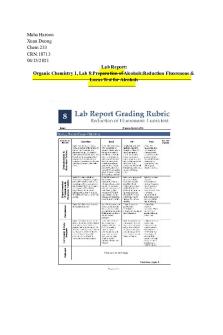Orgo 2 lab 1 - Lab report PDF

| Title | Orgo 2 lab 1 - Lab report |
|---|---|
| Author | Jeffrey Jakubz |
| Course | Organic Chemistry Laboratory Ii |
| Institution | Hunter College CUNY |
| Pages | 4 |
| File Size | 247 KB |
| File Type | |
| Total Downloads | 61 |
| Total Views | 148 |
Summary
Lab report...
Description
Lab 1: Reduction of Camphor to Borneol and Isoborneol Introduction: In order to reduce camphor into isoborneol and borneol, sodium borohydride and methanol can be used. This is done as sodium borohydride gives a hydrogen ion to camphor causing it to lose its carbonyl group, and form an alcohol. When the hydrogen ion attacks, it can either perform an endo attack from the bottom, or an exo attack from the top. Afterwards, the oxygen ion turns into an alcohol after methanol protonates it. When attacking from the bottom through endo attack, isoborneol is produced. When attacking from the top through exo attack, borneol is produced. Due to steric hindrance of the two methyl groups and bridge, attacking from the top is less likely to succeed than attacking from the bottom, where only one methyl group is present.
Results and Observations: Erlenmeyer flask mass: 24.52g Ernlenmeyer flask + product: 24.64g Mass of product: 24.64g-24.52g=0.12g Substance
Literature Value (°C)
Observed Melting point (°C)
Camphor
170°
158°-159°
Borneol/Isoborneol mixture
220°
208°-211°
This IR spectroscopy graph does not show a peak at 1720, indicating the loss of the carbonyl group.
The NMR ratio indicates Borneol to be 25% and isoborneol to be 75% of the product.
Treatment of results:
OC H 3 ¿ 4 4 C 10 H 16 O+ NaB H 4 + 4 C H 3 OH → 4 C 10 H 18 O+NaB ¿
Theoretical yield: Moles of camphor: 0.25g / (152.23g/mol) = 0.0016 moles Moles of sodium borohydride: 0.25g / (37.83g/mol) = 0.066 moles Camphor is the limiting reagent, so product is also 0.0016 moles Grams borneol/isoborneol: 0.0016 mol * 154.25g/mol = 0.2533g Actual yield= 0.12g Percent yield= 0.12g/0.2533g *100% = 47.37% Discussion/Conclusion: As the reaction proceeds, the hydrogen from sodium borohydride conducts nucleophilic attack on the camphor. This causes the pi bond from the carbonyl to shift to the oxygen. The methanol is then able to protonate the oxygen due to its negative charge. The major product for this reaction is isoborneol because endo attack from the bottom is favored as there is less steric hindrance at the bottom. The top has 2 methyl groups, whereas the bottom only has 1.
The melting point showed that the products were pure due to the narrow melting point range. Though it differed from the literature value, this may have been due to the fact that our observed melting point for camphor was also less than the literature value. In addition, our obtained IR showed that the carbonyl group was no longer present in the product, meaning that the hydrogen from sodium borohydride has successfully attacked the structure. The alcohol peak around 3300 however, did not appear, meaning that the reaction did not proceed fully to completion. This may have been due to the fact that the methanol did not react to protonate the oxygen ion. This could have been due to error in not using enough methanol. Furthermore, the NMR spectrum showed us that isoborneol is the major product of this reaction. This is because the hydrogen peak at 4ppm (Borneol) had an integration value of 0.25, whereas the hydrogen peak at 3.6ppm had an integration value of 1.0 (isoborneol). This indicates that there is four times more isoborneol formed as a product than borneol, making borneol the minor product and isoborneol the major product. References: 1) Brown, Muzzio. “An Oxidation-Reduction Scheme: Borneol, Camphor, Isoborneol1.” J Penn, 2012, www.as.wvu.edu/~jpenn/Chem%20339/Experiments/Exp
%2012%20Oxidation-Reduction%20Scheme%20for%20Borneol%20to%20Camphor %20to%20Isoborneol.pdf....
Similar Free PDFs

Lab Report 1 Orgo
- 12 Pages

Orgo 2 lab 1 - Lab report
- 4 Pages

Orgo 2 lab 4 - Lab report
- 14 Pages

Orgo Post-lab 8 - Orgo- Lab report
- 14 Pages

Orgo 2 Lab 3 - Lab report 3
- 5 Pages

Orgo 2 Lab 10 - Lab Report 10
- 4 Pages

Orgo 2 lab 5 - lab report
- 6 Pages

Orgo Lab - Midterm Lab Report
- 10 Pages

Orgo 2 Lab 9 - Lab Report 9
- 4 Pages

Orgo 2 Lab 7 - Lab report 7
- 4 Pages

Orgo Lab 1 Write Up - Lab report
- 3 Pages

Orgo Lab 6 - Lab report
- 6 Pages

Orgo Lab report #3
- 8 Pages

Cholesterol-ORGO-LAB- Report (1)
- 10 Pages

Orgo I Lab Report 1
- 14 Pages
Popular Institutions
- Tinajero National High School - Annex
- Politeknik Caltex Riau
- Yokohama City University
- SGT University
- University of Al-Qadisiyah
- Divine Word College of Vigan
- Techniek College Rotterdam
- Universidade de Santiago
- Universiti Teknologi MARA Cawangan Johor Kampus Pasir Gudang
- Poltekkes Kemenkes Yogyakarta
- Baguio City National High School
- Colegio san marcos
- preparatoria uno
- Centro de Bachillerato Tecnológico Industrial y de Servicios No. 107
- Dalian Maritime University
- Quang Trung Secondary School
- Colegio Tecnológico en Informática
- Corporación Regional de Educación Superior
- Grupo CEDVA
- Dar Al Uloom University
- Centro de Estudios Preuniversitarios de la Universidad Nacional de Ingeniería
- 上智大学
- Aakash International School, Nuna Majara
- San Felipe Neri Catholic School
- Kang Chiao International School - New Taipei City
- Misamis Occidental National High School
- Institución Educativa Escuela Normal Juan Ladrilleros
- Kolehiyo ng Pantukan
- Batanes State College
- Instituto Continental
- Sekolah Menengah Kejuruan Kesehatan Kaltara (Tarakan)
- Colegio de La Inmaculada Concepcion - Cebu
